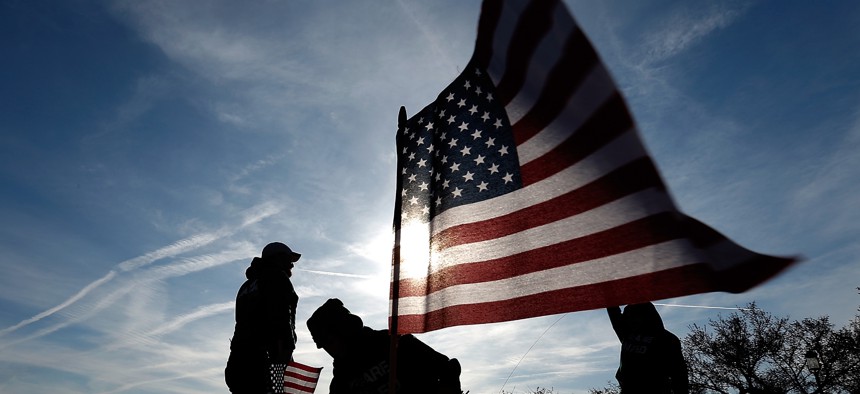
U.S. military veterans set up 1,892 American flags on the National Mall March 27, 2014. According to data from the VA, veteran suicides rose to 6,392 in 2021. Win McNamee / Getty Images
VA hopeful boosted staffing can help reduce rising veteran suicides
With the number of veteran suicides climbing in 2021, the department continues to deploy resources and recruit mental health professionals to help provide care.
The number of veterans dying by suicide grew by 2% to 6,392 in 2021, according to newly released data, marking the first year the figure rose since 2018.
The increase mirrored the jump seen in the non-veteran population, where the number of suicides grew by 5%. Officials at the Veterans Affairs Department, which has designated ending veteran suicide as its top clinical priority and a key pillar of President Biden’s “unity agenda,” stressed that 2021 was the first full year of the COVID-19 pandemic and many of the administration’s efforts were not yet implemented that year.
Since 2021, VA has begun reimbursing veterans in suicidal crisis for any emergency care they receive regardless of whether it occurs at a departmental facility, created the “988 then press one” Veterans Crisis Line and boosted firearm safety efforts. It has also looked to significantly increase its mental health care staffing, doubling its crisis line personnel to 1,800 and beating its goal of adding 30,000 mental health professionals in fiscal 2023.
“We will do everything in our power to learn from this report and use its findings to help us save lives,” VA Undersecretary for Health Shereef Elnahal said. “It will take all of us working together to end veteran suicide, and we will not rest until that goal becomes a reality.”
Certain groups saw bigger increases in 2021 than others: the number of female veterans dying by suicide jumped by 24% and the rate for American Indian and Alaskan Natives was 50%. Matthew Miller, VA’s executive director for the Office of Mental Health and Suicide Prevention, said the pandemic impacted groups disproportionately and access to firearms jumped particularly among female veterans. While the VA has ramped up its efforts generally to discuss firearm safety with veterans, Miller noted the data demonstrated the department did so at a lower rate with women.
The average number of veteran suicides per day was 17.5 in 2021, up from 16.8 in 2020 but down from the high of 18.4 per day in 2018. Nearly 34 out of every 100,000 veterans died by suicide in 2021, up from 32.6 in 2020 and 23.3 in 2001. Suicides are more likely for those within one year of transitioning from active service, with 47 of every 100,000 in that population taking their own lives. Those figures far outpace the non-veteran population, with 16.7 out of every 100,000 dying by suicide in 2021.
Suicide was the 13th leading cause of death among veterans in 2021 and the second-leading cause among veterans under the age of 45.
VA highlighted some areas of success from its annual suicide report, including suicide rates falling by 8.1% for veteran men at least 75 years old. The youngest and oldest cohorts of male veterans who recently interacted with VA saw slightly declining suicide rates. About 38% of veterans who died by suicide in 2021 had recently interacted with the Veterans Health Administration, a slight decrease from 2020 but a significant increase from 20 years prior.
Elnahal said despite beating its “very aggressive hiring targets” in fiscal 2023, the department is still looking to hire as many clinicians in the mental health sphere as possible. He previously called it a key area of focus for staffing growth in fiscal 2024 and told reporters on Wednesday VA would look specifically at hiring “peer specialists” who have lived experience in the military and with mental health disorders. Still, he noted that hiring growth is not a cure-all, as VA must improve its outreach to veterans who do not interact with the department.
“A lot of veterans who die by suicide have never interacted with our mental health system, or a mental health provider overall, which is why we have to think more expansively than just access to health care on this very important mission,” Elnahal said. He stressed the importance of messaging and gun lock distribution efforts.
While VA touted its success in growing the Veterans Crisis Line, the program is now under investigation by the Government Accountability Office after Sen. Jerry Moran, R-Kan., the top Republican on the Senate Veterans Affairs Committee, disclosed whistleblower reports that callers with complex issues were facing indefinite wait times. The team handling those calls is “severely understaffed and undertrained,” Moran said, and the program is facing “gross mismanagement.”
Miller said he appreciated the concerns being brought to his attention and he looked forward to “diving into the facts of that situation” and responding to Moran in a “very detailed way.” He added the crisis line answers 98% of calls overall and 96% of them in 20 seconds or less.
Early indications show overall suicides in the U.S. population are likely to have grown again in 2022 and Miller said he “would not be surprised” if the veteran population mirrored that trend. He is hopeful the Biden administration’s efforts will pay dividends in the years that follow, however.
VA is “seeing some very positive signs for our last fiscal year, so I'm optimistic,” Miller said.
VA Secretary Denis McDonough said that any veteran suicide is unacceptable.
“There is nothing more important to VA than preventing veteran suicide,” McDonough said. “One veteran suicide will always be one too many, and we at VA will use every tool at our disposal to prevent these tragedies and save veterans’ lives.”
Veterans in crisis can contact the Veterans Crisis Line to receive free, confidential support and crisis intervention available 24 hours a day, 7 days a week, 365 days a year. Dial 988 then Press 1, chat online at VeteransCrisisLine.net/Chat, or text 838255.







